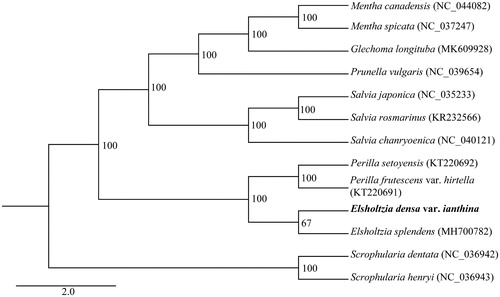Abstract
Elsholtzia densa var. ianthina has important medicinal valve and is used as Tibetan medicine. The complete chloroplast genome of E. densa var. ianthina was assembled from Illumina pair-end sequence reads. The whole plastome is 149,118 bp in length and presents a quadripartite structure consisting of two copies of inverted repeat (IR) regions (25,167) separated by a large single copy (LSC) region (81,411 bp) and a small single copy (SSC) region (17,373 bp). The plastome of E. densa var. ianthina encodes a total of 130 genes, including 85 protein-coding genes, 37 tRNA genes and 8 rRNA genes. The overall GC content of E. densa var. ianthina plastome is 37.9%. A maximum likelihood (ML) phylogenetic analysis revealed that E. densa var. ianthina was related to Elsholtziasplendens.
Elsholtzia densa var. ianthina has important medicinal valve and is widely used in Tibetan medicine (Northwest Plateau Institute of Biology Citation1991). Elsholtzia Willd., a medicinal and economical plant group, is the largest genus in Elsholtzieae (Nepetoideae,Lamiaceae) and contains 43 species (Pu et al. Citation2012; Li et al. Citation2017). However, molecular genetic resources for this important genus are limited and little is known of the genomic information. So far, there has only published one unverified Elsholtzia chloroplast (cp) genome (Elsholtzia splendens). Here, we report and characterize the complete cp genome of E. densa var. ianthina (GenBank accession number: MT083931), which will provide genomic data for molecular studies.
An individual of E. densa var. ianthina was sampled from Jiufeng Mountain (Baotou, Inner Mongolia, China).The specimen was deposited at the herbarium of Baotou Teachers’ College (Accession number: JFS-2019-09-B03XSXR). Total genomic DNA was isolated from silica-dried leaf material using modified CTAB method (Doyle Citation1987), and then was sequenced using an Illumina Hiseq 2500 platform at Biomarker Technologies Inc. (Beijing, China). Firstly, all of the raw reads were trimmed using NGS QC Toolkit_v.2.3.3 with the default parameters set (Patel and Jain Citation2012). Reference-guided assembly was then used to reconstruct the cp genomes with the programs MIRA 4.0.2 (Chevreux et al. Citation2004) and MITObim v1.7 (Hahn et al. Citation2013). In the process, cp genome of Elsholtzia splendens (MH700782) was used as reference genome. The complete cp genome was annotated using the program DOGMA (Wyman et al. Citation2004), and then manually corrected by comparing them with the complete cp genomes of some published Labiatae species in GENEIOUS R10 (Biomatters Ltd., Auckland, New Zealand).
The complete cp genome of E. densa var. ianthina is 149,118 bp in length with a typical quadripartite structure. The large single copy (LSC) region, small single copy (SSC)region and inverted repeat (IRa and IRb) regions are 81,411 bp, 17,373 bp and 25,167 bp, respectively. The assembled plastome encodes a total of 130 genes, consisting of 85 protein-coding genes, 37 tRNA genes, and 8 rRNA genes. The overall GC content of E. densa var. ianthina cp genome is 37.9%, and the corresponding values in LSC, SSC and IR regions are 36.0%, 31.9%, and 43.1%, respectively.
The phylogenetic tree was constructed based on 11 complete cp genomes of Labiatae species and two Scrophulariaceae species as outgroup. All of the 13 complete cp genome sequences were aligned using MAFFT (Katoh and Standley Citation2013) with default parameter and maximum likelihood (ML) analysis was performed using RAxML v8 (Stamatakis Citation2014) with 1000 bootstrap replicates. The phylogenetic tree indicated that E. densa var. ianthina was related to E. splendens ().
Disclosure statement
No potential conflict of interest was reported by the author(s).
Additional information
Funding
References
- Chevreux B, Pfisterer T, Drescher B, Driesel AJ, Müller WE, Wetter T, Suhai S. 2004. Using the miraEST assembler for reliable and automated mRNA transcript assembly and SNP detection in sequenced ESTs. Genome Res. 14(6):1147–1159.
- Doyle JJ. 1987. A rapid DNA isolation procedure for small quantities of fresh leaf tissue. Phytochem Bull. 19:11–15.
- Hahn C, Bachmann L, Chevreux B. 2013. Reconstructing mitochondrial genomes directly from genomic next-generation sequencing reads - a baiting and iterative mapping approach. Nucleic Acids Res. 41(13):e129–e129.
- Katoh K, Standley DM. 2013. MAFFT multiple sequence alignment software version 7: improvements in performance and usability. Mol Biol Evol. 30(4):772–780.
- Li P, Qi ZC, Liu LX, Ohi-Toma T, Lee J, Hsieh TH, Fu CX, Cameron KM, Qiu YX. 2017. Molecular phylogenetics and biogeography of the mint tribe Elsholtzieae (Nepetoideae, Lamiaceae), with an emphasis on its diversification in. Sci Rep. 7(1):1–12.
- Northwest Plateau Institute of Biology. 1991. Tibetan medicine records. Qinghai: Qinghai People’s Press.
- Patel RK, Jain M. 2012. NGS QC Toolkit: a toolkit for quality control of next generation sequencing data. PloS One. 7(2):e30619.
- Pu CX, Chen WY, Zhou ZK. 2012. Elsholtzia litangensis sp. nov. (Lamiaceae) endemic to China. Nord J Bot. 30(2):174–177.
- Stamatakis A. 2014. RAxML Version 8: a tool for phylogenetic analysisand post-analysis of large phylogenies. Bioinformatics. 30(9):1312–1313.
- Wyman SK, Jansen RK, Boore JL. 2004. Automatic annotation of organellar genomes with DOGMA. Bioinformatics. 20(17):3252–3255.

